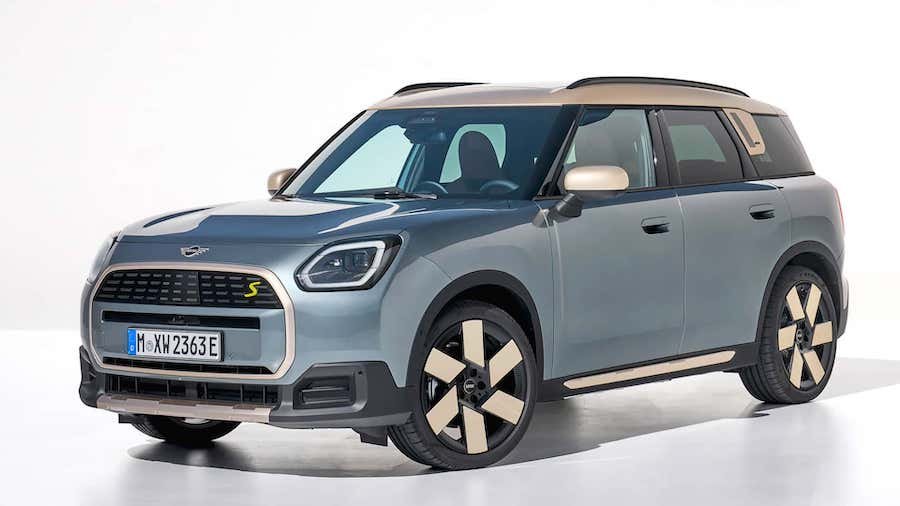Mini Countryman grows and gains electric option for 2024

The largest member of the Mini family, the new Mini Countryman, has grown substantially for its third generation, and will go on sale with petrol and electric drivetrain options early next year.
Being twinned with the latest BMW X1, the Countryman is 60mm longer and 130mm than its predecessor, in part to create room in the line-up for the forthcoming Mini Aceman crossover.
“There’s no Mini in this segment,” company CEO Stephanie Wurst told Autocar, emphasising the impact the increase in size will have on the Countryman’s market positioning.
The SUV “will have new customers” as a result, she said, whereas the subtler evolution of the new Mini Cooper hatchback has been aimed at retaining existing customers.
The Countryman’s exterior design is a clear evolution from the previous two generations, featuring touches also seen on the new Cooper, such as the octagonal front grille and revamped headlights and taillights. Its C-pillar treatment has also been reworked.
The interior features a similarly minimalist look as in the Cooper, with the dashboard dominated by an identical touchscreen. The SUV’s increased in length has allowed for an enlarged centre console featuring larger cupholders and an extra 130mm of leg room in the back, where the backrests are now individually adjustable.
There’s 460/1450 litres of boot space – also representing a slight improvement – plus an underfloor cubby for storing the EV’s charging cables.
Three petrol engines will be available – understood to be two 1.5-litre turbo triples and a 2.0-litre turbo fourpot from the X1. The Countryman C has 167bhp at its front wheels; the S All4 has 215bhp going to both axles; and the John Cooper Works All4 (JCW) gets 296bhp and 295lb ft of torque for a 0-62mph time of 5.4sec.
There will be two electric options at launch: the single-motor, rear-wheel-drive Electric E with 201bhp and the dual-motor, four-wheel-drive Electric SE All4 with 309bhp.
Both feature a 64.7kWh battery, which offers official ranges of 287 and 269 miles and can be rapid-charged at rates of up to 130kW.
Both ICE and EV versions will be offered with a range of three interior trims and eight Mini Experience modes.
Notably, the Countryman will be the first Mini to offer level-two driver assistance, including hands-off driving at speeds of up to 37mph.
Prices start at £28,500 for the C, rising to £33,900 for the S, £39,900 for the JCW and £41,500 for the Electric E and culminating at £46,600 for the Electric SE. UK deliveries will start next Februrary.
First ride: Mini Countryman SE All4
The new Mini Countryman shares a lot of its underpinnings and powertrains with the X1 and iX1, so is it a case of ‘see our BMW X1 review’ for the way it drives? Mini’s engineers are at pains to point out that any Mini should feel like a Mini and have ‘go-kart feeling’.
The latter is likely to be a bit of an overstatement in what's likely going to be a two-tonne EV, but there's certainly room to make the X1 feel a bit more direct and engaging.
At a recent event, I got the opportunity of a short passenger ride in a prototype of the new Countryman. The big change is that it’s noticeably roomier in the back, and the boot space has been boosted too.
Even more obvious is the revolution that has taken place up front. The dashboard and centre console have lost nearly all their buttons, including the rotary infotainment controller. All have been replaced by a very large, very thin, circular OLED touchscreen.
The only physical controls that are left are confined to a small panel with a handful of shortcut buttons, plus the drive selector and the start-stop switch, which takes the form of a classic ignition key affixed to the dash.
The car still ran a prototype build of the infotainment system, with numerous unfinished features and lots of bugs, so it would be unfair to cast judgement on whether this move has been successful. It seems substantially different from the current BMW iDrive system, however.
On the road, the Countryman shares some characteristics with the iX1, of course. Having the same powertrain, it's more than quick enough, and it gets three normal fixed regenerative-braking modes, plus an adaptive mode and a one-pedal ‘B’ mode that will bring the car to a complete stop.
Despite that, it’s quite striking how different the chassis feels from the iX1's. Unlike that car, the Countryman runs passive dampers and fixed-ratio steering, and even from the passenger seat, there's something about its ride and roll rates that makes it feel more alive than the iX1.
This is designed to be a more comfortable car than the outgoing one, as befits its more family-friendly remit. Nevertheless, it’s quite firm-riding, which could prove too much in the UK, but it deals with potholes remarkably well.
The vehicle dynamics engineer who drove us around said the steering where most of the Mini character will come from, but that’s something to verify when we actually get behind the wheel – hopefully later this year.
Related News
